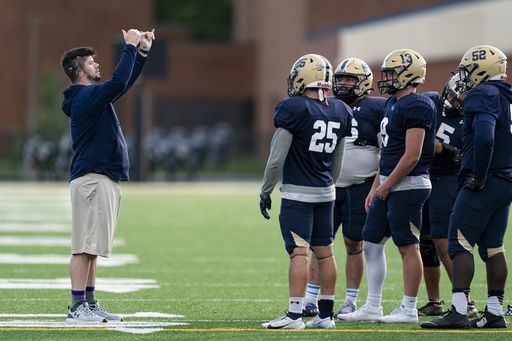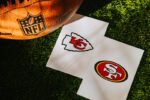Gallaudet has a history of technological innovation with wide applications. The latest is a helmet
Gallaudet assistant coach Shelby Bean, left, coaches players during football practice at Hotchkiss Field, Tuesday, Oct. 10, 2023, in Washington. As a Deaf football player for four years at Gallaudet, Bean called defensive plays with American Sign Language and dealt with other obstacles hearing opponents would never need to worry about. Now he was on the sideline earlier this month when a new football helmet the school developed with AT&T allowed the plays to be displayed visually inside quarterback Brandon Washington’s helmet. (AP Photo/Stephanie Scarbrough)
WASHINGTON (AP) — Shelby Bean could not help but feel a bit jealous.
As a deaf football player for four years at Gallaudet, he called defensive plays with American Sign Language and dealt with other obstacles hearing opponents never need to worry about. Now an assistant coach, he was on the sideline earlier this season for a milestone at a school accustomed to them: The debut of new technolody that allows plays to be displayed visually inside quarterback Brandon Washington’s helmet — a welcomed step that happened to coincide with the team’s first win of the season.
“We go through a lot of challenges,” Bean said. “And we try our best to level the playing field in any way possible.”
Gallaudet has been trying to level the playing field for the Deaf and hard of hearing community for more than a century. The helmet, developed with AT&T 129 years after quarterback Paul Hubbard invented the football huddle, is just the latest example of how the private school has been an incubator for Deaf technology in use around the world.
The innovations outside sports date to at least 1965, when Gallaudet was responsible for the first Dictionary of American Sign Language. The school has since pioneered the use of video phones on campus and the development of translation and ASL recognition applications. Current work includes ways to improve the accuracy of closed captioning.
The technology involved in the helmet could help firefighters, construction workers and first responders in noisy situations while giving the deaf and hard of hearing improved access to jobs and everyday activities.
“Gallaudet University is really the center of the Deaf community,” junior offensive lineman John Scarborough said in ASL through an interpreter. “We’re basically creating history. Usually that first step leads you to huge milestone down the road. I’m sure that my teammates are proud of the history we were able to make and the potential impact that we’re going to have on millions of deaf people, deaf kids around the world.”
The helmet tech works with the push of a button on a tablet on the sideline. The play is beamed over 5G to a tiny, nearly transparent screen in the quarterback’s helmet. Since its debut in that early October win, Gallaudet’s Chuck Goldstein has received dozens of messages and calls from youth coaches and parents asking where they can get it.
The school’s head coach since 2010, he cautioned that it’s just a prototype, used under a one-game waiver by the NCAA. His hope is to get it approved for full-time use moving forward.
“This is just the beginning,” Goldstein said. “This was the experiment — and seeing what this could do and what this could do for not just us but deaf and hard-of-hearing athletes.”
Experts, advocates and those who worked to create the helmet dream of the day the technology is widespread and mainstream, unlike more elaborate visual headsets like Google Glass and Microsoft HoloLens.
Spencer Montan, associate director of the Center on Access Technology for the National Technical Institute for the Deaf at Rochester Institute of Techology, wondered if the captain of a firefighting unit could communicate with someone on the fourth floor with the tech. His boss, Gary Behm, considers it a possible visual replacement for walkie-talkies in various situations.
“We re mostly thinking about employment opportunities,” Behm said in ASL through an interpreter. “So, if you have a deaf worker in a construction site or building skyscrapers, apartment buildings, whatever, you have somebody working up on the second floor and they’re deaf, hearing folks may be on the first floor trying to get their attention thinking how they can communicate with them.”
Closed captioning is perhaps to most well-known example of a Deaf-led innovation that has found its way into everyday life. Videophones — like the ones that debuted on campus at Gallaudet in 2004 — gave way to FaceTime and similar apps. The hope is the helmet technology is the next one to go big.
“Sports has a profound ripple effect within society,” said Brice Christianson, an ASL interpreter who was born to deaf parents and became the CEO of P-X-P, a company that works to make sports more inclusive through interpretation. “I hope it’s a springboard into let’s normalize this, let’s make this commonplace — (that) this just scratches the surface.”
Jason Altmann, P-X-P’s chief operating officer, has seen plenty of innovations not go anywhere because members of the Deaf and hard-of-hearing community were not involved in the process.
They certainly were part of developing the helmet. In addition to a back-and-forth with Gallaudet players and coaches since the idea surfaced in January 2021, AT&T senior VP of networking engineering and operations Corey Anthony said, the company’s Deaf and hard-of-hearing employees were consulted.
Anthony said members of the team “embraced it from Day One, (following the school’s) history of innovation.”
Athletic director Warren Keller said, much like in 1894 with the huddle as a way of keeping opponents from seeing plays being signed, this was a chance for Gallaudet to bridge a gap and solve another communication problem.
“It’s extremely inspiring,” Keller said in ASL through an interpreter. “We care about our place in terms of responsibility for what we provide to our student-athletes and to the world.”
Bean finds it fitting that he and the team could follow in the footsteps of the 19th-century innovators.
“It can have so many more benefits outside of the Deaf and hard-of-hearing community that really just makes everyone’s life better,” he said. “There’s no cap to it. There’s no ceiling. This can go anywhere and everywhere.”
___
AP college football: https://apnews.com/hub/college-football
Copyright 2023 The Associated Press. All rights reserved


